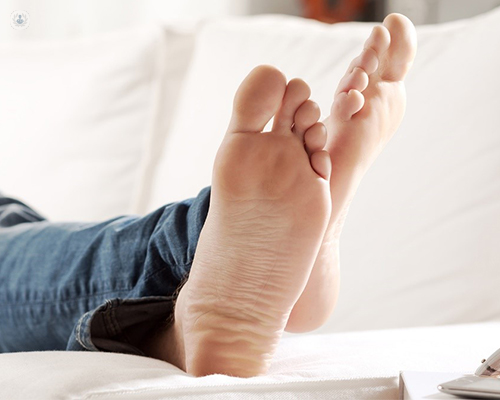Know more about adult flatfoot reconstruction surgery
Written by:Adult acquired flatfoot deformity is a condition in which the arch of the foot can become flatter and cause pain. Orthopaedic specialists, such as consultant orthopaedic surgeon Mr David Redfern, often try to correct these conditions non-operatively, however, surgery is frequently required due to continuing symptoms. Mr Redfern explains how adult acquired flatfoot is corrected surgically.

What is the tibialis posterior tendon?
The tibialis posterior tendon is a muscle in the lower leg and is essential in maintaining the arch of the foot. It attaches the calf muscles to the bones inside your feet.
Tibial tendon dysfunction is a common problem where the tendon becomes inflamed or torn. As a result, the arch of the foot becomes flatter and support in the ankle is lost - which eventually leads to further worsening of the shape of the foot.
If the tendon is weak and the ligaments get stretched out, this can also cause the foot to gradually become flatter. This affects the heel by causing it to drift outwards, thus making the foot roll inwards. The ankle, hindfoot, and midfoot can also lose strength.
Arthritis or injury are also other conditions that can damage tendons and ligaments in the foot leading to gradual failure of important structures.
How is the arch restored?
If the damaged tendon in the foot cannot be repaired, then a new tendon will need to replace it. The tendon that is used as the replacement is called the flexor digitorum longus tendon – it’s one of the tendons that moves the toes.
Before this, the heel bone needs to be realigned to improve the arch of the foot. An incision is made in the heel bone, known as calcaneal osteotomy. A screw is then used to manipulate the bone into a straighter position. For this part, a unique technique known as minimally invasive calcaneal osteotomy (MIMO) is used which Mr Redfern co-developed in order to avoid larger incisions that often leave troublesome scars and nerve damage.
There are times when a cylindrical plug is placed in the heel joint to keep the arch supported and to protect the reconstruction. Furthermore, some patients need to have an additional bone cut in the middle of the foot (cotton osteotomy) to restore the arch.
What is recovery like?
As expected, you will not be able to walk on the operated foot for roughly two to six months. The time it takes to walk again simply depends on what exactly was done during surgery. You will need either crutches, a walker, or a wheelchair for a while.
Your leg will be in a cast for around two weeks after and you’ll need to attend follow up appointments to remove any stitches. After the stitches, we will reapply a new cast or boot.
You will experience moderate swelling of the foot for at least 12 months and you can expect to have soreness and aching for up to six months after.
Are there any risks involved?
As with any surgery, there are some risks involved. For example:
- Infection – the risk of an infection happening is around one per cent. If an infection occurs, then you will receive antibiotics to clear it.
- Bleeding – during surgery, a tourniquet (tight band around the thigh to limit bleeding) is used. After surgery, it’s possible for blood to seep into the bandages and plaster.
- Delayed healing – sometimes, but rarely, the bone cuts are slow to heal. This only happens in about one per cent of cases. There are even times when the bone fails to unite and if this happens, then further surgery will be needed.
- Mal-position – in less than five per cent of cases, the foot can become flat again if the positioning wasn’t adequate during surgery. Mr Redfern always takes the utmost care when judging the best position and correct tension for the tendon graft.
- Complex regional pain syndrome – this is where inflammation of the nerves occurs and can happen following surgery. The risk is less than one per cent and no one really understands why this happens.
- Deep vein thrombosis – a clot of blood in the deep veins of the leg could appear, but there is less than a one per cent chance of this happening. If the leg becomes very swollen or more painful than expected, then we normally perform tests to confirm or exclude this condition.
If you believe you need or are interested in this treatment, book a consultation with Mr David Redfern online via his profile.


